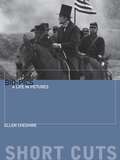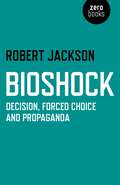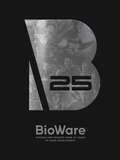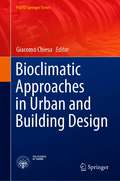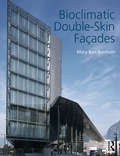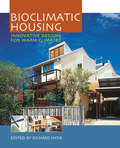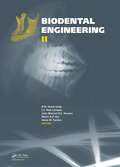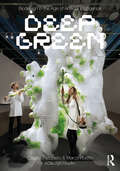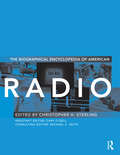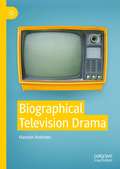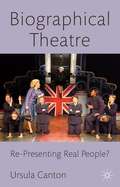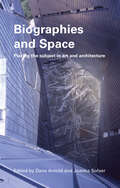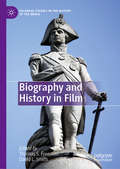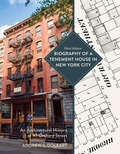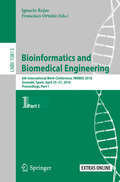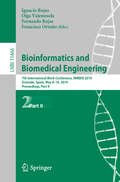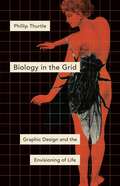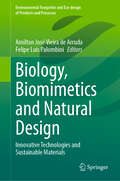- Table View
- List View
Bio-pics: A Life in Pictures
by Ellen CheshireThrough a carefully selected range of thematically linked bio-pics, explores key issues surrounding their resurgence, structure, production, subject representation or misrepresentation, and critical response
Bio-pics: A Life in Pictures (Short Cuts)
by Ellen CheshireBio-pics: A Life in Pictures offers a series of case studies which throw light on this most unique of genres. Is the bio-pic a genre in its own right? Or are such films merely footnotes in other more traditional genres such as the western or costume drama, depending on the historical figure under scrutiny. Unlike other genre forms bio-pics seemingly share no familiar iconography, codes or conventions. They can be set anywhere and at any time. What links them is quite simply that the films depict the life of an 'important' person. Through a carefully selected range of thematically linked (English-language) bio-pics released since 1990 this book explores key issues surrounding their resurgence, narrative structure, production, subject representation or misrepresentation, and critical response. The films under discussion are grouped around a profession (writers, singers, politicians, sportsmen, criminals, artists) allowing for comparisons to be drawn in approaches to similar subject matter.
BioShock: Decision, Forced Choice and Propaganda
by Robert JacksonA historical, critical look at the famous videogame franchise BioShock, understanding it through philosophical, ideological and computational interpretations of systems, decisions and 'propaganda'.
BioWare: Stories and Secrets from 25 Years of Game Development
by BiowareFrom the BioWare's isometric role-playing roots to its intense space operas and living worlds, chart the legendary game studio's first 25 years in this massive retrospective.BioWare - Stories and Secrets from 25 Years of Game Development puts you in the room during key moments in BioWare's history, with never-before-seen art and photos anchored by candid stories from developers past and present. See what it took to make games in those wild early days. Pore over details of secret, cancelled projects. Discover the genesis of beloved characters and games. Presented and designed by Dark Horse Books, this tribute to BioWare's legacy is a must-have for any fan of the best stories you can play.
Bioclimatic Approaches in Urban and Building Design (PoliTO Springer Series)
by Giacomo ChiesaThis book explores the bioclimatic approach to building design. Constant innovations in the field are evident, including the need to face climate changes and increase the local resilience at different scales (regional, urban, architectural). Differently from other contributions, this book provides a definition of the bioclimatic design approach following a technological and performance-driven vision. It includes one of the largest collection of research voices on the topic, becoming also a critical reference work for bioclimatic theory. It is intended for architects, engineers, researchers, and technicians who have professional and research interests in bioclimatic and in sustainable and technological design issues.
Bioclimatic Double-Skin Façades
by Mary Ben BonhamVisually enriched with over 250 photographs and drawings, Bioclimatic Double-Skin Façades is an essential reference guide for understanding the types and functions of double-skin façades. Author Mary Ben Bonham examines the history and continuing potential of double-skin architecture, informing on the variety of approaches possible and advising a rigorous integrated design process leading to application. Featuring a wide selection of architectural examples, the book will be of interest to professionals and students within the fields of architecture, engineering, and construction. Characterized by a buffer-like air space between two glazed building skins, double-skin windows and façades aim to improve building comfort and energy performance. Double skins introduce complexity and initial costs, yet significant buildings in locations around the globe continue to select this approach. In addition to exploring motivations, benefits, and cautions for designing with double skins, the book provides a primer on fundamental façade design concepts and strategies for control of thermal, luminous, and acoustic environments. Chapters also address alternative types of high-performance façades and implications for each phase of façade design and construction. Bioclimatic Double-Skin Façades promotes bioclimatic design that is inspired by nature, measured in performance, and uniquely adapted to climate and place. In-depth case studies illustrate how double-skin façades have been adapted to a range of climates and cultural settings: Marseille Library and Grenoble Courthouse in France, Cambridge Public Library in Massachusetts, Manitoba Hydro Place in Canada, and the Pearl River Tower in China.
Bioclimatic Housing: Innovative Designs for Warm Climates
by Richard HydeIn the search for sustainable architecture, there is growing interest in the relationship between nature and design. In this vital new book, the termbioclimatic relating to the dynamic between climate and living organisms, is applied by the authors in focusing on countries where housing requires cooling for a significant part of the year. In this context, Bioclimatic Housing covers creative, vernacular architecture to present both the theory and practice of innovative, low-energy architecture. The book interweaves the themes of social progress, technological fixes and industry transformation within a discussion of global and country trends, climate types, solutions and technologies. Prepared under the auspices of a 5-year International Energy Agency (IEA) project, and with case studies from Iran, Malaysia, Australia, Japan, Sri Lanka and Italy, this is a truly international and authoritative work, providing an essential primer for building designers, builders, developers and advanced students in architecture and engineering.
Biodental Engineering II
by João Manuel R.S. Tavares R.M. Natal Jorge J.C. Reis Campos Mário A.P. Vaz Sónia M. SantosDentistry is a branch of medicine with its own peculiarities and very diverse areas of action, which means that it can be considered as an interdisciplinary field. BIODENTAL ENGINEERING II contains the full papers presented at the 2nd International Conference on Biodental Engineering (BioDENTAL 2012, Porto, Portugal, 7-8 December 2012). The contrib
Biodesign in the Age of Artificial Intelligence: Deep Green
by Marco Poletto Claudia PasqueroBiodesign in the Age of Artificial Intelligence: Deep Green investigates the potential of nature-based technology for shaping the evolution of contemporary architecture and design. It takes on the now pervasive topic of design intelligence, extending its definition to encompass both biological and digital realms. As in their first title, Systemic Architecture: Operating Manual for the Self-Organizing City, the authors engage the topic through the specific lens of their innovative design practice, ecoLogicStudio, and their research at the University of Innsbruck and at the Bartlett, UCL. Part One of the book, entitled PhotoSynthetica™, illustrates design solutions that engage the urban microbiome and seek to achieve an immediate impact, while Part Two, entitled Deep Green, includes synthetic landscapes and operates within a much larger spatio-temporal frame, going beyond human perception and life span to envision design as a geographical and geological force. In the age of catastrophic climate change, such perceptual expansion helps to clarify that change cannot simply be stopped or rolled back. We must instead establish more positive dynamics of change within the living world. To this end, this book proposes to engage with design and architecture as an extended cognitive interface, a sentient being that is co-evolutionary and symbiotic with the living planet, contributing to its beauty and to our continued enjoyment of it.
Biographical Encyclopedia of American Radio
by Christopher H. SterlingThe Biographical Encyclopedia of American Radio presents the very best biographies of the internationally acclaimed three-volume Encyclopedia of Radio in a single volume. It includes more than 200 biographical entries on the most important and influential American radio personalities, writers, producers, directors, newscasters, and network executives. With 23 new biographies and updated entries throughout, this volume covers key figures from radio’s past and present including Glenn Beck, Jessie Blayton, Fred Friendly, Arthur Godfrey, Bob Hope, Don Imus, Rush Limbaugh, Ryan Seacrest, Laura Schlesinger, Red Skelton, Nina Totenberg, Walter Winchell, and many more. Scholarly but accessible, this encyclopedia provides an unrivaled guide to the voices behind radio for students and general readers alike.
Biographical Television Drama
by Hannah Andrews“Biographical Television Drama breaks new ground as, to my knowledge, the first book-length exploration of the terms in which television engages in biographical storytelling. Backed by robust research in biography studies and British television history, Hannah Andrews deftly unravels the complexities behind the accessibility of biographical television drama. Her book tackles key questions head-on, notably rhetorics and style, narrative and performance and, innovatively, ethics, while also shedding light on the interconnections with other biographical screen forms through a rich corpus. This is an essential critical study that vindicates television drama’s unique place in the histories and practices of screen biography.”-Belén Vidal, Senior Lecturer in Film Studies at King’s College London and co-editor of The Biopic in Contemporary Film CultureThis book explores what happens when biography and television meet, in a novel fusion of the two fields of study. Andrews compares core concepts in biography and television studies such as intimacy, the presentation of the self and the uneasy relationship between fact and fiction. The book examines biographical drama’s generic hybridity, accounting for the influence of the film biopic, docudrama, melodrama and period drama. It discusses biographical television drama’s representation of real lives in terms of visual style, performance and self-reflexivity. Andrews also assesses how life stories are shaped for televisual narrative formats and analyses the adaptation process for the biographical drama. Finally, the book considers various kinds of reputation – of the broadcast institution, author, biographical subject – in relation to the ethics of televisual biography.
Biographical Theatre
by Ursula CantonMarilyn Monroe, Vincent van Gogh or the victims of rendition flights - the number and variety of historical and contemporary figures represented on British stages is amazing. This book develops a new theoretical framework for the representation of real life figures on stage and examines different ways in which they can be included in performances.
Biographies & Space: Placing the Subject in Art and Architecture
by Dana Arnold Joanna Sofaer DerevenskiBringing together a collection of high-profile authors, Biographies and Space presents essays exploring the relationship between biography and space and how specific subjects are used as a means of explaining sets of social, cultural and spatial relationships. Biographical methods of historical investigation can bring out the authentic voice of subjects, revealing personal meanings and strategies in space as well as providing a means to analyze relations between the personal and the social. Writing about both actual (architectural) and imagined (pictorial) space, the authors consider issues of gender, childhood, sexuality and race, highlighting an increasing fluidity and interaction between theory, methods and history. Biographies and Space is an original and exciting new book, with direct relevance to both architectural and art history.
Biography and History in Film (Palgrave Studies in the History of the Media)
by David L. Smith Thomas S. FreemanThe essays in this volume seek to analyze biographical films as representations of historical individuals and the times in which they lived. To do this, contributors examine the context in which certain biographical films were made, including the state of knowledge about their subjects at that moment, and what these films reveal about the values and purposes of those who created them. This is an original approach to biographical (as opposed to historical) films and one that has so far played little part in the growing literature on historical films. The films discussed here date from the 1920s to the 2010s, and deal with males and females in periods ranging from the Middle Ages to the end of the twentieth century. In the process, the book discusses how biographical films reflect changing attitudes towards issues such as race, gender and sexuality, and examines the influence of these films on popular perceptions of the past. The introduction analyses the nature of biographical films as a genre: it compares and contrasts the nature of biography on film with written biographies, and considers their relationship with the discipline of history. As the first collection of essays on this popular but understudied genre, this book will be of interest to historians as well as those in film and cultural studies.
Biography of a Tenement House in New York City: An Architectural History of 97 Orchard Street
by Andrew S. Dolkart"I trace my ancestry back to the Mayflower," writes Andrew S. Dolkart. "Not to the legendary ship that brought the Pilgrims to Plymouth, Massachusetts, in 1620, but to the more prosaic tenement on the southeast corner of East Broadway and Clinton Street named the Mayflower, where my father was born in 1914 to Russian-Jewish immigrants." For Dolkart, his father's experience of being raised in a tenement became a metaphor for the life that was afforded countless immigrant children growing up in Lower Manhattan during the past century. In this revised edition of his classic book, Dolkart presents for us a precise and informative biography of a typical tenement house in New York City that became, in 1988, the site for the Lower East Side Tenement Museum. The author documents, analyzes, and interprets the architectural and social history of this building at 97 Orchard Street, beginning in the 1860s when it was erected, moving on to the late nineteenth and early twentieth centuries when the neighborhood started to change, and concluding in the present day as the building is reincarnated as the museum. This edition includes new research on the basement storefronts (specifically the Schneider saloon and the kosher butcher), the backyard privies and their reconstruction, and the new Irish Moore apartment. Biography of a Tenement House in New York City is a lasting tribute to the legacy of immigrants and their children, who were part of the transformation of New York City and the fabric of everyday American urban life. Distributed for the Center for American Places at ColumbiaCollege Chicago
Bioinformatics and Biomedical Engineering: 5th International Work-Conference, IWBBIO 2017, Granada, Spain, April 26–28, 2017, Proceedings, Part I (Lecture Notes in Computer Science #10208)
by Ignacio Rojas and Francisco OrtuñoThis two volume set LNBI 10208 and LNBI 10209 constitutes the proceedings of the 5th International Work-Conference on Bioinformatics and Biomedical Engineering, IWBBIO 2017, held in Granada, Spain, in April 2017. The 122 papers presented were carefully reviewed and selected from 309 submissions. The scope of the conference spans the following areas: advances in computational intelligence for critical care; bioinformatics for healthcare and diseases; biomedical engineering; biomedical image analysis; biomedical signal analysis; biomedicine; challenges representing large-scale biological data; computational genomics; computational proteomics; computational systems for modeling biological processes; data driven biology - new tools, techniques and resources; eHealth; high-throughput bioinformatic tools for genomics; oncological big data and new mathematical tools; smart sensor and sensor-network architectures; time lapse experiments and multivariate biostatistics.
Bioinformatics and Biomedical Engineering: 5th International Work-Conference, IWBBIO 2017, Granada, Spain, April 26–28, 2017, Proceedings, Part II (Lecture Notes in Computer Science #10209)
by Ignacio Rojas and Francisco OrtuñoThis two volume set LNBI 10208 and LNBI 10209 constitutes the proceedings of the 5th International Work-Conference on Bioinformatics and Biomedical Engineering, IWBBIO 2017, held in Granada, Spain, in April 2017. The 122 papers presented were carefully reviewed and selected from 309 submissions. The scope of the conference spans the following areas: advances in computational intelligence for critical care; bioinformatics for healthcare and diseases; biomedical engineering; biomedical image analysis; biomedical signal analysis; biomedicine; challenges representing large-scale biological data; computational genomics; computational proteomics; computational systems for modeling biological processes; data driven biology - new tools, techniques and resources; eHealth; high-throughput bioinformatic tools for genomics; oncological big data and new mathematical tools; smart sensor and sensor-network architectures; time lapse experiments and multivariate biostatistics.
Bioinformatics and Biomedical Engineering: 6th International Work-Conference, IWBBIO 2018, Granada, Spain, April 25–27, 2018, Proceedings, Part I (Lecture Notes in Computer Science #10813)
by Ignacio Rojas Francisco OrtuñoThis two-volume set LNBI 10813 and LNBI 10814 constitutes the proceedings of the 6th International Work-Conference on Bioinformatics and Biomedical Engineering, IWBBIO 2018, held in Granada, Spain, in April 2018.The 88 regular papers presented were carefully reviewed and selected from 273 submissions. The scope of the conference spans the following areas: bioinformatics for healthcare and diseases; bioinformatics tools to integrate omics dataset and address biological question; challenges and advances in measurement and self-parametrization of complex biological systems; computational genomics; computational proteomics; computational systems for modelling biological processes; drug delivery system design aided by mathematical modelling and experiments; generation, management and biological insights from big data; high-throughput bioinformatic tools for medical genomics; next generation sequencing and sequence analysis; interpretable models in biomedicine and bioinformatics; little-big data. Reducing the complexity and facing uncertainty of highly underdetermined phenotype prediction problems; biomedical engineering; biomedical image analysis; biomedical signal analysis; challenges in smart and wearable sensor design for mobile health; and healthcare and diseases.
Bioinformatics and Biomedical Engineering: 6th International Work-Conference, IWBBIO 2018, Granada, Spain, April 25–27, 2018, Proceedings, Part II (Lecture Notes in Computer Science #10814)
by Ignacio Rojas Francisco OrtuñoThis two volume set LNBI 10813 and LNBI 10814 constitutes the proceedings of the 6th International Work-Conference on Bioinformatics and Biomedical Engineering, IWBBIO 2018, held in Granada, Spain, in April 2018.The 88 regular papers presented were carefully reviewed and selected from 273 submissions. The scope of the conference spans the following areas: bioinformatics for healthcare and diseases; bioinformatics tools to integrate omics dataset and address biological question; challenges and advances in measurement and self-parametrization of complex biological systems; computational genomics; computational proteomics; computational systems for modelling biological processes; drug delivery system design aided by mathematical modelling and experiments; generation, management and biological insights from big data; high-throughput bioinformatic tools for medical genomics; next generation sequencing and sequence analysis; interpretable models in biomedicine and bioinformatics; little-big data. Reducing the complexity and facing uncertainty of highly underdetermined phenotype prediction problems; biomedical engineering; biomedical image analysis; biomedical signal analysis; challenges in smart and wearable sensor design for mobile health; and healthcare and diseases.
Bioinformatics and Biomedical Engineering: 7th International Work-Conference, IWBBIO 2019, Granada, Spain, May 8-10, 2019, Proceedings, Part I (Lecture Notes in Computer Science #11465)
by Ignacio Rojas Francisco Ortuño Olga Valenzuela Fernando RojasThe two-volume set LNBI 11465 and LNBI 11466 constitutes the proceedings of the 7th International Work-Conference on Bioinformatics and Biomedical Engineering, IWBBIO 2019, held in Granada, Spain, in May 2019. The total of 97 papers presented in the proceedings, was carefully reviewed and selected from 301 submissions. The papers are organized in topical sections as follows: Part I: High-throughput genomics: bioinformatics tools and medical applications; omics data acquisition, processing, and analysis; bioinformatics approaches for analyzing cancer sequencing data; next generation sequencing and sequence analysis; structural bioinformatics and function; telemedicine for smart homes and remote monitoring; clustering and analysis of biological sequences with optimization algorithms; and computational approaches for drug repurposing and personalized medicine. Part II: Bioinformatics for healthcare and diseases; computational genomics/proteomics; computational systems for modelling biological processes; biomedical engineering; biomedical image analysis; and biomedicine and e-health.
Bioinformatics and Biomedical Engineering: 7th International Work-Conference, IWBBIO 2019, Granada, Spain, May 8-10, 2019, Proceedings, Part II (Lecture Notes in Computer Science #11466)
by Ignacio Rojas Francisco Ortuño Olga Valenzuela Fernando RojasThe two-volume set LNBI 11465 and LNBI 11466 constitutes the proceedings of the 7th International Work-Conference on Bioinformatics and Biomedical Engineering, IWBBIO 2019, held in Granada, Spain, in May 2019. The total of 97 papers presented in the proceedings, was carefully reviewed and selected from 301 submissions. The papers are organized in topical sections as follows: Part I: High-throughput genomics: bioinformatics tools and medical applications; omics data acquisition, processing, and analysis; bioinformatics approaches for analyzing cancer sequencing data; next generation sequencing and sequence analysis; structural bioinformatics and function; telemedicine for smart homes and remote monitoring; clustering and analysis of biological sequences with optimization algorithms; and computational approaches for drug repurposing and personalized medicine. Part II: Bioinformatics for healthcare and diseases; computational genomics/proteomics; computational systems for modelling biological processes; biomedical engineering; biomedical image analysis; and biomedicine and e-health.
Biology in the Grid: Graphic Design and the Envisioning of Life (Posthumanities)
by Phillip ThurtleHow grids paved the way for our biological understanding of organisms As one of the most visual sciences, biology has an aesthetic dimension that lends force and persuasion to scientific arguments: how things are arranged on a page, how texts are interspersed with images, and how images are composed reflect deep-seated beliefs about how life exists on Earth. Biology in the Grid traces how our current understanding of life and genetics emerged from the pervasive nineteenth- and twentieth-century graphic form of the grid, which allowed disparate pieces of information to form what media theorist Vilém Flusser called &“technical images.&”Phillip Thurtle explains how the grid came to dominate biology in the twentieth century, transforming biologists&’ beliefs about how organisms were constructed. He demonstrates how this shift in our understanding of biological grids enabled new philosophies in endeavors such as advertising, entertainment, and even political theory. The implications of the arguments in Biology in the Grid are profound, touching on matters as fundamental as desire, our understanding of our bodies, and our view of how society is composed. Moreover, Thurtle&’s beautifully written, tightly focused arguments allow readers to apply his claims to new disciplines and systems. Bristling with insight and potential, Biology in the Grid ultimately suggests that such a grid-organized understanding of natural life inevitably has social and political dimensions, with society recognized as being made of interchangeable, regulated parts rather than as an organic whole.
Biology, Biomimetics and Natural Design: Innovative Technologies and Sustainable Materials (Environmental Footprints and Eco-design of Products and Processes)
by Felipe Luis Palombini Amilton José Vieira de ArrudaFor billions of years, nature has provided efficient solutions to complex problems, by means of natural selection, in a harsh environment that only the fittest organisms survived. Such sustainable – still ruthless – driven evolution can be explored by designers, architects, engineers and more for the development of innovative projects. Biomimetics makes the link between Biology and Design, where features like shapes, mechanisms, colors, structures, and more can be analyzed, organized, modeled, and simulated for application in multiple creations. Therefore, such knowledge can contribute to more efficient and innovative solutions to many fields of applied science. This project aims to highlight some of the recent technological breakthroughs in Biology, Biomimetics and Natural Design that contribute to the development of sustainable and innovative materials and projects. This work consists of contributions from some of the main international groups of Biomimetics, exhibiting exciting cases of how technological advancements are leading to improved design solutions as well as shaping our very comprehension of nature and its complex organization.
Biomedical Engineering Systems and Technologies: 10th International Joint Conference, Biostec 2017, Porto, Portugal, February 21-23, 2017, Revised Selected Papers (Communications In Computer And Information Science #881)
by Nathalia Peixoto Margarida Silveira Hesham H. Ali Carlos Maciel Egon L. van den BroekThis book constitutes the thoroughly refereed post-conference proceedings of the 10th International Joint Conference on Biomedical Engineering Systems and Technologies, BIOSTEC 2017, held in Porto, Portugal, in February 2017.The 20 revised full papers presented were carefully reviewed and selected from a total of 297 submissions. The papers are organized in topical sections on biomedical electronics and devices; bioimaging; bioinformatics models, methods and algorithms; bio-inspired systems and signal processing; and health informatics.
Biomedical Engineering Systems and Technologies: 11th International Joint Conference, BIOSTEC 2018, Funchal, Madeira, Portugal, January 19–21, 2018, Revised Selected Papers (Communications in Computer and Information Science #1024)
by Paul Anderson Reyer Zwiggelaar Ana Fred Hugo Gamboa Giovanni Saggio Alberto Cliquet Jr. Sheldon Wiebe Sergi Bermúdez i BadiaThis book constitutes the thoroughly refereed post-conference proceedings of the 11th International Joint Conference on Biomedical Engineering Systems and Technologies, BIOSTEC 2018, held in Funchal, Madeira, Portugal, in January 2018.The 25 revised full papers presented were carefully reviewed and selected from a total of 299 submissions. The papers are organized in topical sections on biomedical electronics and devices; bioimaging; bioinformatics models, methods and algorithms; health informatics.
